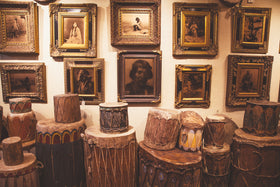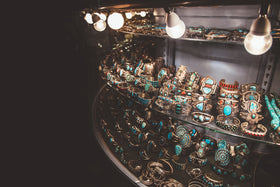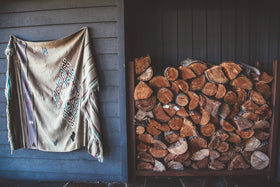Native American Beaded Gauntlets

Gauntlets have been around for centuries and were originally designed to protect European and Asian bow hunters and military archers from the snapping of their bowstrings. Leather gauntlets appeared in the American West as military uniform accessories. They were soon adopted by Native American artists and incorporated into the civilian wardrobe.
 Civil War Gauntlets Plateau Beaded Gauntlets
Civil War Gauntlets Plateau Beaded Gauntlets
Self-adornment is important to many Native American tribes. Traditionally, Native Americans decorated garments with porcupine quills, feathers, animal hair and plant-based dyes. Prior to European contact the most abundant material for garments was either animal hide from bear, deer, elk and moose, or woven plant fibers. However, when less common materials became available, they were quick to work them into their traditional practices.
Although inter-tribal trade occurred, European contact introduced Native Americans to a greater number of options including beads, cloth, weapons and horses. Through outside trade, fiber cloth garments were eventually replaced by trade cloth or a combination of animal hide and cloth. Traditional hand drilled beads made from stone, bone and shell were often replaced with glass beads in red, yellow, blue and white, and by the late 18th century/early 19th century, horses were widely available. Plains, Plateau, and Great Basin Indians became known for their horsemanship and began decorating horse gear. The visual enhancement of clothing and horse gear is a strong part of Native American culture to this day.

Geometric Floral Pictorial
Around the middle part of the 19th century, trade beads became much smaller. These beads, coined “seed beads,” allowed for far more detailed bead work styles to develop such as the geometric patterns, floral designs and pictorial imagery regularly found in Plateau, Plains, and Great Basin beaded pieces of the period.

Faceted Beads Metal Beads
During this time a common item to bead was gauntlets. While not a part of traditional Native American dress, these large cuffed leather gloves were decorated by Native Americans and sold and traded to natives and non-natives alike. The gauntlets of this period featured both opaque and translucent beads, some cut with flat faces or sides that sparkle. Cut beads were available at the turn of the 19th century in the eastern parts of North America and were slowly traded west. Metal beads became available by mid-19th century.
Two primary bead working techniques were adopted to account for smaller bead size. The lane stitch more commonly referred to as the “lazy stitch” and the overlay stitch. The lane stitch was used to cover large areas of cloth or hide with rows or lanes of beads. Each lane contained a string of six to eight beads that would then be affixed to the garment at the ends.
The overlay stitch was regularly used with curved designs. This stitch utilizes two pieces of thread, one to string the beads and to bend the line of beads into the intended outline and one to affix the first thread every few beads. Floral designs were commonly done with the overlay stitch. As time went on, non-natives influence on Native American styles and designs continued to increase. Petunias were desirable in the 1920’s and roses by the 1940’s. Pictorial-style bead work was favored throughout the 20th century. Images of a man on horseback or wildlife on the landscape were attractive patterns. Many Native Americans beaded what they saw in daily life including patriotic flags and government seals. Plateau bead workers often depicted important game animals such as deer, elk and bear. The importance of the horse was often reflected in bead work as well. The possibilities of what could be beaded were endless.

Sioux Horse Pictorial Gauntlets
Gauntlets were generally only worn for special events, while decorated gloves could be worn for a variety of occasions. By the 19th century beaded gauntlets became a necessary accessory to the western cowboy’s fancy attire. The popularity of rodeo and western pageants post 1900 increased this demand. Beading gloves was a means for Native American women to express their creativity while incorporating cultural traditions. Throughout the 1930’s styles and fashion trends changed slowing the demand for decorated gauntlets, however, some artists today still make gauntlets and other beaded items preserving their artistic and cultural heritage. The fact that beaded gauntlets were made for outside use does not diminish their beauty, quality, importance or value.





 Civil War Gauntlets Plateau Beaded Gauntlets
Civil War Gauntlets Plateau Beaded Gauntlets